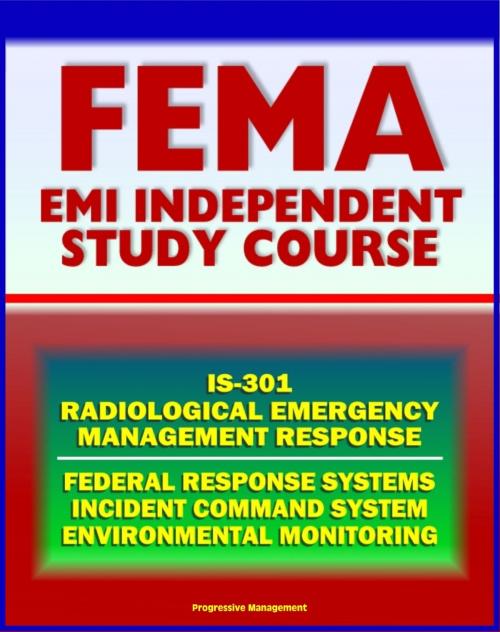21st Century FEMA Radiological Emergency Response Independent Study Course (IS-301), Nuclear Power Plant and Reactor Accidents, Radiation Monitoring, Incident Command System, Biological Effects
Nonfiction, Science & Nature, Science, Biological Sciences, Ecology, Social & Cultural Studies, Political Science| Author: | Progressive Management | ISBN: | 9781458040602 |
| Publisher: | Progressive Management | Publication: | March 14, 2011 |
| Imprint: | Smashwords Edition | Language: | English |
| Author: | Progressive Management |
| ISBN: | 9781458040602 |
| Publisher: | Progressive Management |
| Publication: | March 14, 2011 |
| Imprint: | Smashwords Edition |
| Language: | English |
This vital Federal Emergency Management Agency (FEMA) independent training course manual from the Emergency Management Institute (EMI) provides authoritative, official information about radiological emergency response. This course, IS-301, includes: Regulations and Guides for Radiation Protection and Response * Nuclear Physics for Radiological Emergency Response * Biological Effects and Internal Hazards of Radiation Exposure * External Dosimetry * Protection Actions and Protective Action Guides * Federal Response Systems * Incident Command System * Public Information and Media Relations * Environmental Monitoring * Introduction to Nuclear Reactors * Radioactive Materials Transportation * Radiological Hazard Area Control. This is one of the series of influential FEMA documents providing crucial material on disasters and emergency response.
The goal of the Radiological Emergency Response Independent Study (RERIS) course is to provide a learning experience in which participants demonstrate comprehensive understanding of radiological protection and response principles, guidelines, and regulations through a cycle of text, stimulus, response, and reinforcement. This course of instruction will improve the performance of radiological response team members. At the conclusion of this course, learners will be able to do the following: Differentiate between regulations, standards, law, license conditions, Regulatory Guides, Nuclear Regulatory Commission Regulatory (NUREG) documents, and Radiological Emergency Preparedness (REP) reports that apply to radiological emergency response operations; Apply basic concepts of nuclear and health physics appropriate to the needs of radiological emergency response personnel; Convert between traditional and SI units of radiation and radiation exposure; Convert between “standard notation” and “scientific notation”; Associate various biological effects with levels of exposure to ionizing radiation; Trace the pathway of radioactive material into, through, and out of the human body; Select appropriate external dosimetry for radiological emergency response operations and identify limitations of dosimetry devices; Associate radiation protection principles and procedures with characteristics of nuclear radiation; Define the Environmental Protection Agency (EPA) Protective Action Guides (PAGs) and the recommendations of the National Council on Radiation Protection and Measurements (NCRP); Summarize the Federal/State/local government relationship for different types of radiological emergencies; Plan radiological emergency response operations that are consistent with the Incident Command System (ICS) Differentiate between the roles of the media, the public information officer, and the radiological response team in radiological emergency response operations; Give reasons for and components of environmental monitoring in a radiological emergency; Apply knowledge of nuclear power plant structure, operations, and emergency response procedures to the role of the radiological response team member in a related emergency; Apply knowledge of radioactive materials transportation regulations to the role of the radiological response team member in responding to a related emergency; and Develop a checklist for analysis and control of a radiological hazard area.
This is a privately authored news service and educational publication of Progressive Management. Our publications synthesize official government information with original material - they are not produced by the federal government. They are designed to provide a convenient user-friendly reference work to uniformly present authoritative knowledge that can be rapidly read, reviewed or searched. Vast archives of important data that might otherwise remain inaccessible are available for instant review no matter where you are. This e-book format makes a great reference work and educational tool.
This vital Federal Emergency Management Agency (FEMA) independent training course manual from the Emergency Management Institute (EMI) provides authoritative, official information about radiological emergency response. This course, IS-301, includes: Regulations and Guides for Radiation Protection and Response * Nuclear Physics for Radiological Emergency Response * Biological Effects and Internal Hazards of Radiation Exposure * External Dosimetry * Protection Actions and Protective Action Guides * Federal Response Systems * Incident Command System * Public Information and Media Relations * Environmental Monitoring * Introduction to Nuclear Reactors * Radioactive Materials Transportation * Radiological Hazard Area Control. This is one of the series of influential FEMA documents providing crucial material on disasters and emergency response.
The goal of the Radiological Emergency Response Independent Study (RERIS) course is to provide a learning experience in which participants demonstrate comprehensive understanding of radiological protection and response principles, guidelines, and regulations through a cycle of text, stimulus, response, and reinforcement. This course of instruction will improve the performance of radiological response team members. At the conclusion of this course, learners will be able to do the following: Differentiate between regulations, standards, law, license conditions, Regulatory Guides, Nuclear Regulatory Commission Regulatory (NUREG) documents, and Radiological Emergency Preparedness (REP) reports that apply to radiological emergency response operations; Apply basic concepts of nuclear and health physics appropriate to the needs of radiological emergency response personnel; Convert between traditional and SI units of radiation and radiation exposure; Convert between “standard notation” and “scientific notation”; Associate various biological effects with levels of exposure to ionizing radiation; Trace the pathway of radioactive material into, through, and out of the human body; Select appropriate external dosimetry for radiological emergency response operations and identify limitations of dosimetry devices; Associate radiation protection principles and procedures with characteristics of nuclear radiation; Define the Environmental Protection Agency (EPA) Protective Action Guides (PAGs) and the recommendations of the National Council on Radiation Protection and Measurements (NCRP); Summarize the Federal/State/local government relationship for different types of radiological emergencies; Plan radiological emergency response operations that are consistent with the Incident Command System (ICS) Differentiate between the roles of the media, the public information officer, and the radiological response team in radiological emergency response operations; Give reasons for and components of environmental monitoring in a radiological emergency; Apply knowledge of nuclear power plant structure, operations, and emergency response procedures to the role of the radiological response team member in a related emergency; Apply knowledge of radioactive materials transportation regulations to the role of the radiological response team member in responding to a related emergency; and Develop a checklist for analysis and control of a radiological hazard area.
This is a privately authored news service and educational publication of Progressive Management. Our publications synthesize official government information with original material - they are not produced by the federal government. They are designed to provide a convenient user-friendly reference work to uniformly present authoritative knowledge that can be rapidly read, reviewed or searched. Vast archives of important data that might otherwise remain inaccessible are available for instant review no matter where you are. This e-book format makes a great reference work and educational tool.















